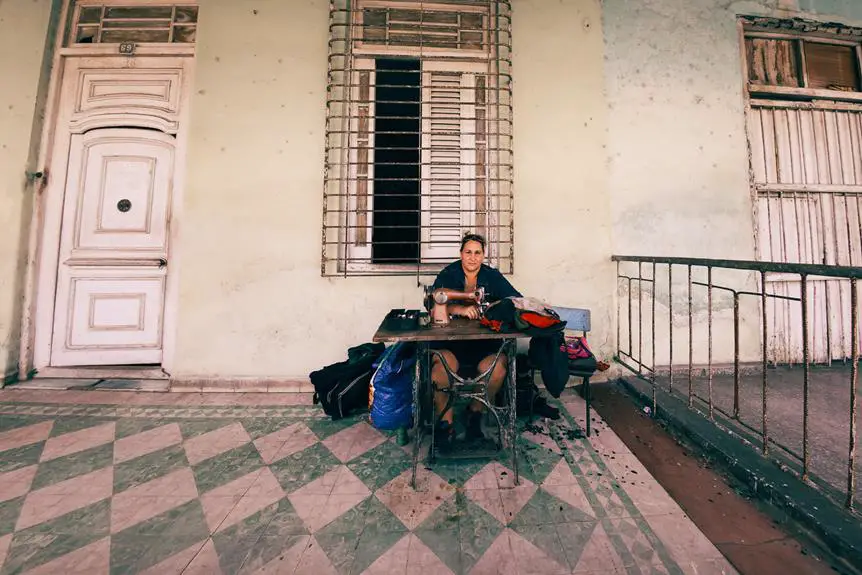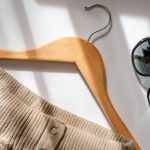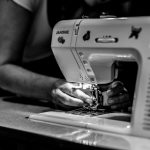Sewing thick fabrics can sometimes feel like trying to stitch through a brick wall. But fear not, mastering the art of sewing thick fabrics is within your reach. With the right techniques, you can navigate through those layers with ease and finesse.
In this guide, you will discover five essential tips that will elevate your sewing game when tackling heavy, resistant fabrics. From choosing the right needle and thread to perfecting your finishing techniques, these tips will empower you to conquer even the most formidable fabrics.
So, grab your tools and let's dive into the world of sewing thick fabrics like a pro!
Key Takeaways
- Use a size 16 or 18 needle and heavy-duty thread for sewing thick fabrics.
- Adjust machine tension properly to avoid issues like loose stitches and thread breakage.
- Choose the right stitch length for different fabric types to prevent bunching or tension.
- Utilize supportive tools such as walking foot, Teflon foot, and fabric stabilizer for sewing thick fabrics.
Choosing the Right Needle and Thread
Use a size 16 or 18 needle and heavy-duty thread when sewing thick fabrics to ensure smooth and secure stitching. The needle size is crucial when working with thick fabrics. A larger needle can easily penetrate the fabric without causing damage, while a smaller needle may bend or break.
Additionally, heavy-duty thread is designed to withstand the tension and wear that comes with sewing thick materials. It's thicker and stronger than regular sewing thread, providing the durability needed for sturdy seams. When choosing the right thread thickness, consider the weight and density of the fabric. Thicker fabrics require thicker thread to ensure that the stitches hold up over time.
Using the appropriate needle size and thread thickness won't only make the sewing process smoother but will also result in a professional-looking finish. Remember, the right tools are essential for mastering the art of sewing thick fabrics.
Adjusting Machine Tension
When sewing thick fabrics with a size 16 or 18 needle and heavy-duty thread, you will need to adjust the machine tension to accommodate the increased thickness and density of the material. Incorrect tension can lead to issues such as loose stitches, thread breakage, or puckering of the fabric. Proper tension ensures that the stitches penetrate the fabric evenly and create a strong, balanced seam. Here are some key fabric handling and tension troubleshooting tips to help you achieve optimal results:
| Issue | Symptoms | Solution |
|---|---|---|
| Loose stitches | Stitches are loopy or easily pulled out | Increase the upper tension slightly |
| Thread breakage | Thread snaps during sewing | Decrease the upper tension or check for burrs on the needle |
| Puckering of the fabric | Fabric gathers or puckers along the seam | Decrease the upper tension or use a walking foot to feed the fabric evenly |
Adjusting machine tension for thick fabrics is crucial for achieving professional-looking results. By understanding fabric handling and knowing how to troubleshoot tension issues, you can confidently tackle sewing projects involving heavy materials.
Using Proper Stitch Length
To achieve strong, balanced seams when sewing thick fabrics, it's essential to consider the appropriate stitch length for the material's density and weight. Proper machine settings play a crucial role in achieving the desired stitch length.
When dealing with heavy fabrics, such as denim or canvas, opt for longer stitch lengths to prevent the fabric from bunching up or creating too much tension. Generally, a stitch length of 3mm to 4mm works well for these fabrics.
On the other hand, for lighter weight fabrics like silk or chiffon, a shorter stitch length is recommended to ensure that the seams hold up well without puckering.
Fabric preparation also influences the choice of stitch length. It's important to pre-test the stitch length on a scrap of the same fabric to determine the most suitable setting before beginning the actual sewing process.
Employing Supportive Tools
You'll need specific sewing machine presser feet that are designed to handle thick fabrics effectively. These supportive tools will aid in achieving professional results when sewing through heavy materials.
Additionally, fabric preparation is crucial for successful sewing with thick fabrics. Here's how you can employ supportive tools and prepare your fabric for optimal results:
- Sewing Machine Presser Feet:
Invest in a walking foot or a roller foot to help feed thick fabrics evenly through the machine.
Consider using a Teflon or non-stick foot for fabrics that tend to stick or drag, such as leather or vinyl.
- Fabric Preparation:
Prior to sewing, consider using a fabric stabilizer or interfacing to provide extra support to the fabric.
Always press and flatten seams before sewing over them, as this will reduce bulk and make sewing through thick layers easier.
Finishing Techniques for Thick Fabrics
To achieve a professional finish when working with thick fabrics, it's essential to employ appropriate techniques for seam and edge finishes. When sewing thick fabrics, seam reinforcement and edge binding are crucial to ensure durability and a polished look. Here are some effective finishing techniques to consider:
| Seam Reinforcement | Edge Binding |
|---|---|
| Use topstitching or | Binding tape or |
| edge stitching to secure | bias binding can |
| and reinforce seams. | provide a clean |
| This helps prevent | and sturdy edge. |
Frequently Asked Questions
How Can I Prevent My Sewing Machine From Getting Stuck or Jammed When Sewing Thick Fabrics?
To prevent jamming when sewing thick fabrics, adjust your machine's tension and use a larger needle size. Prepare the thick fabric by pressing and using a walking foot. These steps will help you sew smoothly without any issues.
What Type of Presser Foot Is Best for Sewing Thick Fabrics?
When sewing thick fabrics, the best presser foot to use is a walking foot. It helps to feed the fabric evenly and prevents layers from shifting. Regular sewing machine maintenance also ensures smooth sewing of thick fabrics.
Are There Any Special Techniques for Sewing Through Multiple Layers of Thick Fabric?
When sewing through multiple layers of thick fabric, use specialized needles to prevent breakage and ensure proper tension adjustment for smooth stitching. Experiment with different needle sizes and adjust the tension as needed for best results.
How Can I Avoid Breaking Needles When Sewing Thick Fabrics?
To avoid breaking needles when sewing thick fabrics, adjust your machine's thread tension to accommodate the fabric's thickness. Use the proper needle size for thick fabrics and go slow to prevent needle breakage.
What Are Some Tips for Sewing Thick Fabrics on a Serger or Overlock Machine?
When using a serger for thick fabrics, adjust the tension for a balanced stitch. Shorten the stitch length to ensure a secure seam. Experiment with scrap fabric to find the ideal settings for your specific material.
- How to Wash Snowe Percale Sheets: A Brand-Specific Care Guide - July 14, 2025
- What Is Percale Linen? Understanding This Unique Fabric Blend - July 14, 2025
- Are Percale Sheets Scratchy? What to Expect and How to Soften Them - July 14, 2025






